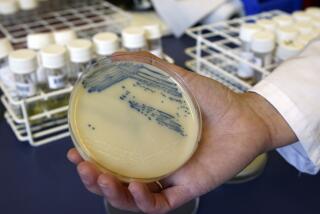The Common Cold Meets Its Match
- Share via
As we cough, sneeze and sniff our way through the cold season, it may comfort us to know that technology has finally caught up with our expectations. Two new medicines promise to cure the common cold.
The drugs, one of which may be available within the next several months, stop cold viruses in their tracks, not just mask symptoms like current remedies. Patients who have taken them report feeling better almost immediately, sleeping through the night and having to use fewer tissues on the cold’s hallmark runny nose. And one of the drugs also treats a handful of rare, but often life-threatening, ills such as chronic meningitis.
“These drugs are part of a revolution in the treatment of virally caused diseases,” says Catherine Laughlin, chief of virology at the National Institute of Allergies and Infectious Diseases in Bethesda, Md.
Researchers fighting cold viruses have benefited both from the massive research effort to combat AIDS, a viral disease caused by HIV, and the development of tools that allow them to peer deep inside a cell. With these advances, they’ve learned how to overcome two major hurdles in devising an effective cold medicine.
The first was that viruses are tough to hit with any accuracy because they insinuate themselves inside cells. In contrast, bacteria colonize in bodily fluids and cavities, making them easy pickings for antibiotics.
Added to this was the fact that there wasn’t just one kind of pesky microbe to keep at bay. A couple of different families of viruses, including rhinoviruses and coronaviruses, cause the majority of colds.
And within these groups, more than 110 distinct rhinovirus types have been identified, while three or four different coronaviruses infect humans.
“The challenge has been to find a single drug that would work against the different families of viruses as well as one that would precisely target the virus without hurting the cells,” says the institute’s Laughlin.
Viruses are tiny capsules of protein that are much smaller than bacteria--the common analogy is that if a bacterium is equivalent to the size of a human, then a virus would be as large as an arm. Unlike almost any other living organism, viruses are incapable of reproducing themselves.
Instead, they must slither through a cell’s wall and commandeer the host’s genetic machinery, using it to churn out identical copies of themselves.
The two cold remedies now in the pipeline prevent this replication, thwarting the viruses without causing any apparent collateral damage in the host cells.
“Both of these drugs are very potent antiviral agents that work against a broad spectrum of different rhinoviruses,” says Dr. Ronald B. Turner, a professor of pediatrics at the University of Virginia in Charlottesville.
Jamming the Copier
Each drug attacks the virus at a different stage of its life cycle but ends up with the same result--the virus can’t make copies of itself. One drug, called AG7088 for now because it’s in an early stage of development, is a protease inhibitor similar to the drugs that revolutionized AIDS treatment.
“The protease inhibitor halts the action of a key enzyme that the virus needs to replicate,” preventing the virus from squirting its genetic information into the cell’s DNA, says Laughlin. The medication has blocked enzyme activity in 100 strains of the cold virus, according to recent research.
The drug, a nasal spray that is inhaled several times daily, is made by Agouron Pharmaceuticals, a La Jolla biotechnology company. It is now in the middle of the second phase of human testing, according to an Agouron spokesperson (new drugs normally go through three phases of human trials before they’re submitted for FDA approval).
Preliminary tests show that AG7088 reduces cold symptoms, while people who received a placebo or dummy pill experienced a full-blown cold.
Because the three phases of drug tests can be lengthy, AG7088 isn’t expected on the market for several years.
The other new medicine is Picovir, which is awaiting FDA approval and may be available in your local pharmacy within the next year.
Taken in a pill form, Picovir prevents the cold virus from entering the cell.
Scientists discovered this approach because of the development of an X-ray in the mid-1980s that had enough magnification to take detailed photographs of viruses. These X-rays revealed that picornaviruses, of which the cold-causing rhinoviruses are one, have a deep pocket or canyon that runs across the viral surface, or coat. Picovir wedges firmly inside this pocket, like a plug in a drain, and stops the virus from shedding its outer coating. If it can’t shed its coat, the virus can’t penetrate the cell membrane and infect the cell.
“We didn’t really know if blocking that one site would interfere with the life cycle of all these viruses,” says Mark McKinlay, vice president of research and development for ViroPharma, the Exton, Pa., company that makes Picovir. “But after much trial and error, we discovered a compound that locks tightly on to that site. The more tightly the drug binds, the greater the potency of the drug.”
In drug tests of more than 4,000 patients, people felt less miserable within 24 hours, and those who received the drug recovered a day sooner than the control group. “The drug reduces viral shedding, too,” says McKinlay, “which suggests that it cuts down the rate at which colds are spread.”
Picovir may prove most beneficial for people who are more vulnerable to a viral onslaught--the elderly, people with defective immune systems or those who suffer from ills like asthma. “The common cold can be fatal for someone whose immune system is compromised,” says Dr. Jose R. Romero, an associate professor of pediatrics at the University of Nebraska Medical Center in Omaha who has researched Picovir. “Rhinoviruses also trigger asthma, the No. 1 chronic illness in children. Preventive use might decrease the incidence of attacks.”
Picovir can also combat serious diseases caused by an enterovirus, another member of the picornavirus family, such as myocarditis, an often fatal inflammation of the heart, chronic meningitis, polio, and neonatal infections. And for a number of these patients, Picovir, which has been dispensed on a compassionate basis to more than 400 people, has been, quite literally, a life saver.
Normally, many people suffering from chronic viral meningitis, for example, a once-incurable brain infection, slowly degenerate. “Picovir reverses that course,” says ViroPharma’s McKinlay. “There’s been some pretty amazing recoveries.”
Other scientists have achieved similar results using Picovir to treat polio, where the drug cleared the virus from the patient’s body, and infections that sometimes kill or severely sicken newborns.
“Anecdotal data indicates it works,” says Romero. “If a large-scale study, which is currently underway, confirms these findings, it will be a major step forward in the treatment of this disease.”
*
No Immediate Relief
Still, there are a few drawbacks that may stand in the way of Picovir or AG7088 becoming true blockbusters. Though they reduce the severity and duration of cold symptoms--without the unpleasant side effects of current medications--they aren’t instant cures.
By the time you start feeling sick, you’ve been under siege for two to three days, which means the virus has established a firm toehold in the body. To get the maximum benefit from an antiviral medication like Picovir, you need to get a prescription the minute you start feeling sick.
Two antiviral flu medications that were approved in the past two years, Relenza and Tamiflu, have similar downsides--they only shorten the duration of the flu, and they have to be taken within the first two days of the appearance of symptoms.
“Treating viral infections depends on early diagnosis and therapy,” says Dr. Harley A. Rotbart, a professor and vice chairman of pediatrics at the University of Colorado School of Medicine in Denver. “If you wait until the virus has ravaged the body, treatment will have less of an impact.”
Another catch is that Picovir only foils the rhinovirus, which is responsible only for about half of all colds. If you’re attacked by another bug, it won’t help.
What’s more, the cold’s symptoms--the drippy nose, stuffed up sinuses, cough, mild fever, sneezing, scratchy throat, and headaches--are actually an inflammatory response, sparked by your immune system’s efforts to fight off the viral invaders.
Consequently, to get the kind of overnight relief we’ve gotten from antibiotics will require a one-two punch: an antiviral to stop the pathogens, and an agent to quell the cascade of immune reactions.
“There are two separate components to treating the common cold,” says Rotbart, who has studied Picovir. “We have to shut off the faucet, which Picovir seems to do, and then drain what’s in the basin.”
Despite these drawbacks, experts are optimistic about Picovir’s ability to short-circuit colds.
“This is good antiviral drug, and it’s a clear advance over what we have now,” says Turner of the University of Virginia. “But when we get down to the practical issue of treating the common cold, Picovir may have some uphill battles” because it doesn’t offer immediate relief and must be taken before people are really sick, he says.
Still, though Picovir or AG7088 may not work with the speed and efficiency of antibiotics, as the first medications that treat the underlying cause of colds and attack viruses at the molecular level, they are a promising start. And they might also curb overprescribing of antibiotics.
“The single most common reason for antibiotic misuse is patients begging for prescriptions for the kind of viral infection Picovir treats, and this would give doctors another option,” says Rotbart.
“And patients do start feeling better right away. If we could reeducate patients and physicians to begin treatment at the first sign of a cold, I think we can do even better in cutting short symptoms.”






